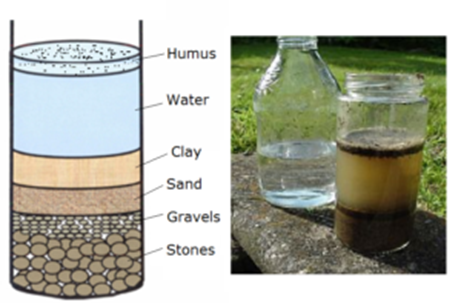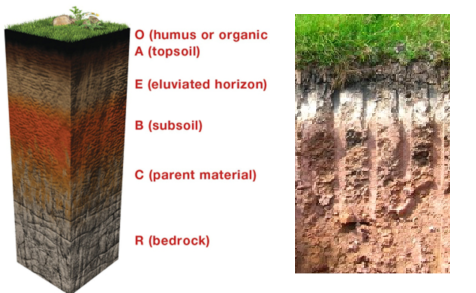Science > Biology > Soil Management > Soil Profile
A vertical section through different layers of the soil is called the soil profile. Each layer differs in feel (texture), colour, depth, and chemical composition. These layers are called horizons. Soil texture depends on the size of individual soil particles and is determined by the relative proportions of particle sizes that make up the soil. The texture affects the amount of water that can be absorbed for use by plants and animals. We usually see the top surface of the soil. Topsoil that is nutrient-rich, containing a mixture of humus, clay, and minerals, is most suitable for plant growth. • Most animals live in the topsoil horizon.
Soil Particle Sizes Which Determine Soil Profile:
- Stone: Particles of large size
- Gravel – particles greater than 2 mm in diameter.
- Coarse sand – particles less than 2 mm and greater than 0.2 mm in diameter.
- Fine sand – particles between 0.2 mm and 0.02 mm in diameter.
- Silt – particles between 0.02 mm and 0.002 mm in diameter
- Clay – particles less than 0.002 mm in diameter
Experiment to Understand Soil Profile:
We can perform this simple activity to show that the soil is composed of distinct layers.
Procedure: Take a little soil and break the clumps to powder it (don’t use crusher, do it by your hand). add a handful of this powdered soil in a transparent glass tumbler. Stir the suspension with a stick so that the soil gets dissolved. Let the suspension stand undisturbed for some time.

Observations: We see layers of particles of different sizes in the glass tumbler. There is a topmost layer of some dead rotting leaves or animal remains floating on water. This rotting dead matter in the soil is called humus. Below the layer of humus, there is a clear water level which contains dissolved part from the soil. Below water layer, there are layers of clay, sand, gravel and stones.
To observe the layers below we have to study recently dug a ditch. Soil profile can also be seen while digging a well or during laying the foundation of a building. It can also be seen at a steep river bank.

- O – Horizon: The uppermost layer or horizon is thin and generally dark in colour due to the richness of humus. It is made up of living and decomposed and decomposing materials like leaves, plants and decaying or decayed dead terrestrial animals. The humus makes the soil fertile and provides nutrients to growing plants. This layer is called ‘O’ horizon.
- A – Horizon: The layer below ‘O’ horizon is called topsoil or ‘A’ horizon. This layer is made up of minerals and decomposed organic matter and it is also very dark in colour. This layer is generally soft, porous and can retain more water. This is the layer that many plants roots grow in. This layer provides shelter for many living organisms such as worms, rodents, moles and beetles.
- E – Horizon: It is a mineral horizon present only in forested areas below ‘A’ horizon and above ‘B’ horizon. It is a light coloured, leached (washed down or eluviated due to rainwater from ‘A’ level) horizon. Mainly it contains silicates.
- B – horizon: The next layer is ‘B’ horizon and also referred as “subsoil”. This layer has clay and mineral deposits and less organic materials (humus) and more amount of minerals than the layers above it. This layer is also lighter in colour than the layers above it. This layer is generally harder and more compact
- C – Horizon: Next layer is called the ‘C’ horizon also referred as “regolith”. It is made up of small lumps of rocks with cracks and crevices. A little bit of organic material is found here. Plant roots are not found in this layer. The layer also referred as parent material layer. Because of these lumps, the soil is formed.
- R – Horizon: Next layer is bedrock layer and also referred as ‘R’ horizon. This layer is hard and difficult to dig with a spade.
Constituents of Soil:
Soil contains organic and inorganic constituents. Fine particles of quartz, feldspar, mica, carbonates of metals, oxides, and sulphides of iron are present in the soil as inorganic part. The organic constituents consist of particles from both the plant and the animal origin. The soil contains numerous organisms ranging from microscopic bacteria to large soil animals such as earthworms. The soil micro-organisms include bacteria, fungi, actinomycetes, algae, protozoa and nematodes. Those from plant origin are bacteria, algae, fungi, decaying leaves, etc. Those from the animal origin include protozoa, worms, insects, shells and decaying bodies of dead animals.
Colour of Soil:
Colour is an important physical property of soils that allows us to know some of its most important characteristics, such as mineral composition, age and soil processes, chemical alteration, carbonate accumulation, the presence of humified organic matter, etc. The presence of water in the soil profile during long periods of time affects soil color as a result of changes in the oxidation rate.
The soil may be black, red, yellow or copper coloured. From the colour of the soil, we get an idea of the fertility, drainage, and other such properties. The colour of soil depends on the texture, organic content and chemical substances like iron, quicklime that it may contain.
Properties Determining Soil Quality:
- Permeability: Soil particles have open spaces (pores) between them that let water flow through. The permeability of soil is the easiness by which water flows through it. The closer the particles pack together because of particle size, the less permeable the soil is. Permeability of soil is measured by calculating the rate of drainage of water through it.
- pH: Soils can be basic or acidic and usually measure the pH of the soil is found to be in the range 4 – 10. pH less than 7 shows the soil is acidic while pH above 7 shows soil is basic. Most plants grow best in soils with a pH of between 5 and 7. Lime is a kind of fertilizer that alters pH and making the soil nutrients more accessible.
Ground water:
Due to the permeability of soil and rocks water soaks into the ground. It percolates downward through the zone of aeration till it reaches hard rock which is not permeable. The percolated water gets collected over the surface of hard rock and is called groundwater. The area where the water has filled all the space in the soil is called the zone of saturation; the top of this zone is called the water table. • Groundwater can also flow slowly through the underground rock or be stored in underground layers called aquifers. Groundwater is naturally purified as it soaks through the soil layers.
Surface water:
The water which is not soaked in runs downhill as springs, rivers and is called surface water. An area that is drained by a river and all the streams that empty into it, the tributaries, is called a drainage basin or watershed.
Previous Topic: Soil and its Types
Next Topic: Soil Testing (On Farm Testing)
2 replies on “Soil Profile”
The knowledge I got after reading this article is great. Well researched and formatted well. Really liked it.
Clear descriptions are so good to see and pretty helpful for better understanding. Nice work sir.